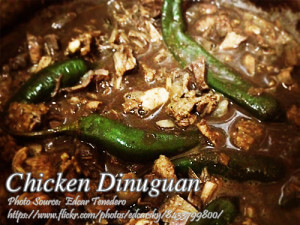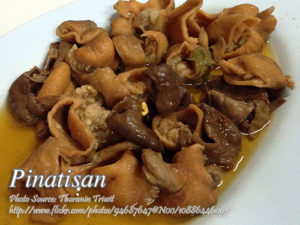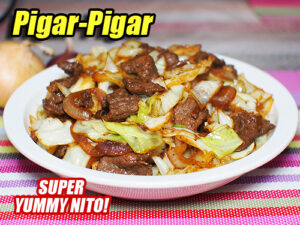Dagupan kaleskes is a dish made out of cow or carabao meat and its internal organs in a hot, delicious, orange colored broth. The dish got its name from ‘Kaleskes’ which is a Pangasinan word for intestines.
A Nostalgic Taste of Ilocos
Growing up in a small town, Sunday meals were always a special time for our family. It was the only day of the week when everyone had a chance to gather around our long, wooden dining table. My Uncle Lito would often take charge of the cooking, and he’d always bring with him dishes from his travels. One of my favorite dishes he introduced us to was kaleskes, a hearty and flavorful soup from Ilocos Norte, which quickly became a staple on our family’s table.
I still remember the first time Uncle Lito made this dish. We all watched with curiosity as he cleaned beef intestines and tripe, something we weren’t used to seeing in our usual everyday meals. It seemed complicated at first, but with the right techniques and a little patience, this Ilocano classic is actually quite simple to prepare. And I’ve followed his steps ever since.
What is Kaleskes?
For those unfamiliar, it is an Ilocano delicacy made from offal, particularly beef or carabao intestines, tripe, and sometimes tendons. It’s like a comforting bowl of soup with a rich, earthy flavor. The name itself comes from the Ilocano word “kaleskes,” which translates to “intestines.” But don’t let that intimidate you—if prepared right, the intestines become tender and soak up all the delicious flavors from the broth.
Interestingly, it is not only a regular dish served at home in Ilocos but also a street food staple, often sold in roadside eateries or “carinderias.” It’s usually served during special occasions or gatherings, where its warm, hearty goodness comforts everyone at the table. In fact, some locals even say it’s the perfect “pulutan” when you’re enjoying an ice-cold beer with friends!
Preparing the Offal: A Family Tip
The process of cleaning and cooking the intestines and tripe can seem intimidating, but trust me, once you get the hang of it, it’s quite easy. Uncle Lito always insisted on cleaning them thoroughly under running water to remove any impurities. This is an essential step because it ensures that the offal doesn’t have any unwanted odors or taste. He would often say, “Patience is key when cleaning these parts, but it’s worth every minute.”
To get that tender, melt-in-your-mouth texture, he would then place the cleaned intestines and tripe in a pressure cooker with just enough water to cover them. Pressure cooking speeds up the process, and in less than an hour, you’re left with meat that’s tender but still has a slight chew to it—a texture that’s important for this dish.
If you don’t have a pressure cooker, don’t worry. You can simmer the intestines and tripe on the stove for a longer time, but be prepared to wait a little longer. Either way, the key is making sure they’re cooked just right—soft but not mushy.
Cooking The Aromatic Base
Once the offal is ready, the next step is sautéing. My cousin Marites, who now lives in Manila but never misses a chance to cook this dish, insists that the sautéing process is where the magic happens. You start by heating a bit of oil and sautéing garlic, ginger, and onions until the onions are soft and fragrant. Ginger, in particular, is a must because it helps cut through any lingering gamey flavors from the offal, while the garlic adds depth to the broth.
The key here is to sauté the intestines and tripe for a few minutes to allow the flavors to meld. After about four minutes, you’ll add vinegar, an ingredient common in many Filipino dishes. Uncle Lito would always remind us not to stir right after adding the vinegar, as this helps reduce the sourness and ensures a more balanced flavor.
Adding Color and Flavor: Annatto Water
One of the distinct features of the dish is its reddish hue, which comes from annatto seeds. I remember my mother, Maria, telling me that back in the day, her own mother would use annatto seeds not just for color but also for a subtle nutty flavor. To achieve this, you simply soak the seeds in hot water, stir until the water turns a deep orange, and then strain the liquid into the pot. This adds both a visual appeal and an extra layer of flavor that makes the dish stand out.
Bringing it All Together: The Final Touches
Once the annatto water is in, it’s time to bring everything together. Pour in your beef stock, bring the pot to a boil, and season with salt and pepper. After cooking for about 20 more minutes, the soup becomes rich and hearty. The offal absorbs the flavors, and the broth gets a nice balance of spices and warmth.
Adding green chilies and spring onions towards the end gives the dish a fresh kick. The chilies, in particular, add a subtle heat that cuts through the richness of the broth, while the spring onions lend a pop of color and a hint of freshness.
Finally, the dish is ready to serve, and every time I make it, I can’t help but feel a sense of nostalgia. The warm, comforting smell fills the house, taking me back to those Sunday lunches with Uncle Lito at the helm, the whole family eagerly waiting for a bowl of kaleskes.
A Taste of Home
There’s something about kaleskes that always brings me back to my roots. It’s not just the flavors that make this dish so special—it’s the memories, the family gatherings, and the stories behind it. If you’ve never tried it, I encourage you to give it a shot. Not only is it a delicious and hearty meal, but it also offers a little taste of Ilocos’ culinary heritage.
And who knows? It might just become a favorite in your household, too, just like it has in ours.
Kaleskes Recipe
Ingredients
- 1 kilo beef small intestines or beef sirloin or carabeef sirloin thoroughly cleaned
- 1 kilo beef tripe or beef tendons or carabeef tendons thoroughly cleaned
- 1/2 cup cane or palm vinegar
- 12 cups beef stock from the boiled intestines and tripe
- 3 stalks spring onions sliced
- 6 pcs green finger chillies
- 3 pcs large onions finely chopped
- 2 whole garlic minced
- 2 inch ginger sliced into strips
- 3 Tbsp. annatto seeds
- 1/2 Tbsp. ground black pepper
- rock salt to taste
- cooking oil
Instructions
How to Cook Kaleskes
- If you are using beef or carabeef intestines and tripe, clean the intestines and tripe in running water and drain.
- Put in a pressure cooker and fill with water just enough to cover the meat. Cook it until almost tender.
- Follow the same procedure if you are using carabeef tendons and sirloin.
- In a large pot, heat 3 Tbsp. cooking oil and sauté garlic, ginger and onions until the onions are soft.
- Add the tripe and intestines (or tendons and sirloin) and stir. Sauté for 4 minutes in high heat.
- Add the vinegar and let it simmer for 1 minute, do not stir.
- Meanwhile, add 1/2 cup hot water to the annatto seeds and stir until the water turns reddish.
- Add the annatto water by straining the seeds and pouring it in the pot.
- Pour the beef stock in the pot and bring to a boil. Season with salt and pepper then cook again for 20 minutes or until tender.
- Add the green chilies, spring onions and adjust the seasoning if needed.
- Turn off heat and transfer to a serving bowl. Serve hot.
Notes
Cooking Tips:
Clean the Offal Thoroughly
To ensure the best flavor and texture, always clean the intestines and tripe thoroughly under running water. Removing any impurities prevents unwanted odors from affecting the dish. This step is key to achieving a clean and delicious broth.Don’t Stir After Adding Vinegar
When adding vinegar, allow it to simmer for a minute without stirring. This helps reduce the sharpness of the vinegar and balances the flavors of the broth. Stirring too soon can result in a harsh, overpowering sourness.Use Annatto Water for Rich Color
Soaking annatto seeds in hot water adds both color and a subtle nutty flavor to the dish. Strain the liquid before adding it to the pot to avoid gritty textures from the seeds. This simple step enhances the visual appeal of the soup.Nutrition Notes:
Calorie and other nutrition information is derived from HappyFolks.Com recipe nutrition calculator. The percent daily value (%DV) is based on a daily 2,000 calorie diet.Nutrition Facts:
Amount per Serving:550g, Calories:339kcal, From fat:171, Total fat:19.2g, Saturated Fat:9.4g, Trans Fat:0.2g, Cholesterol:195mg, Sodium: 865 Total Carbohydrate: 6g, Dietary Fiber: 1g, Sugars: 2g, Protein: 34g, Vitamin A: 8%, Vitamin C: 116%, Calcium: 15%, Iron: 15%




